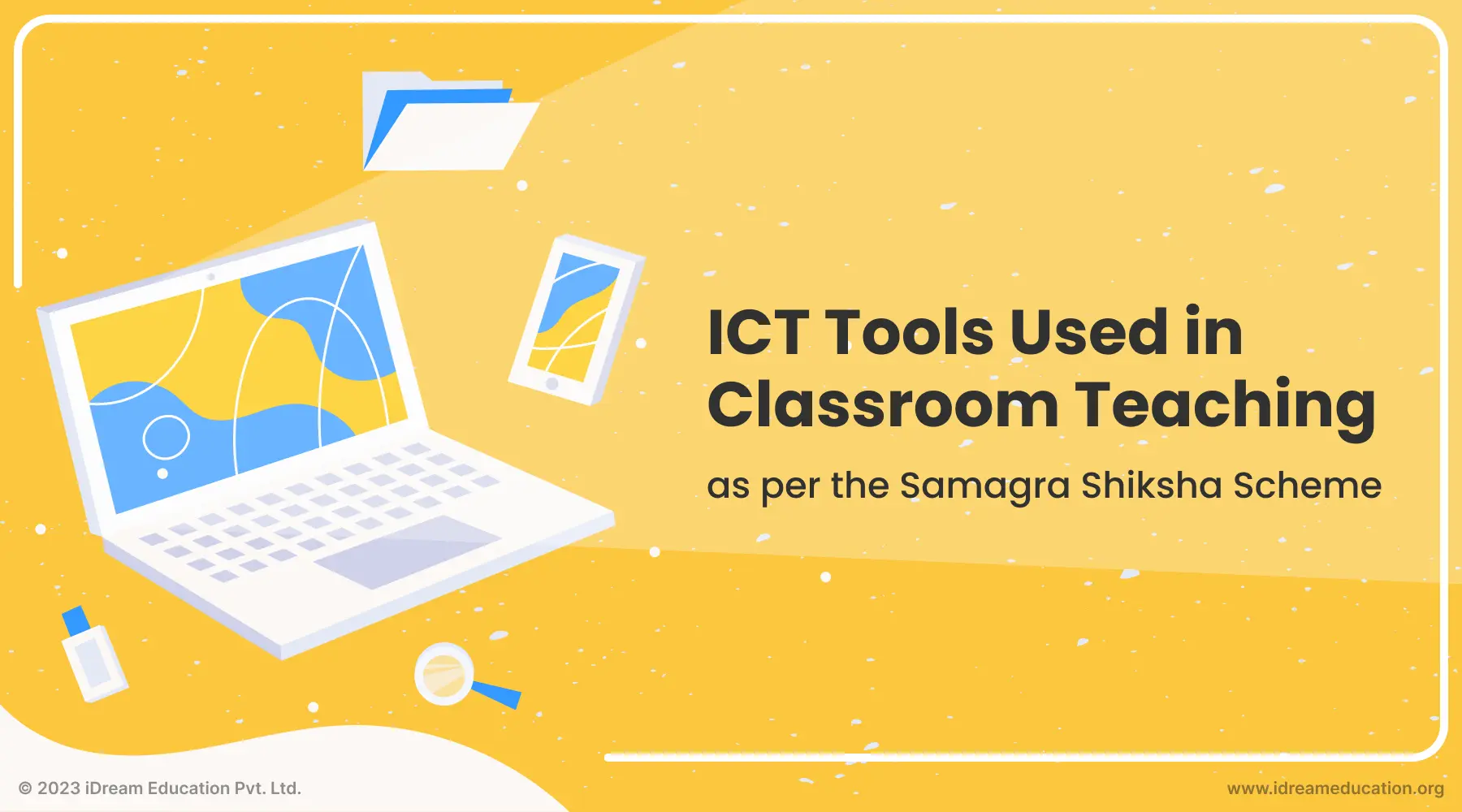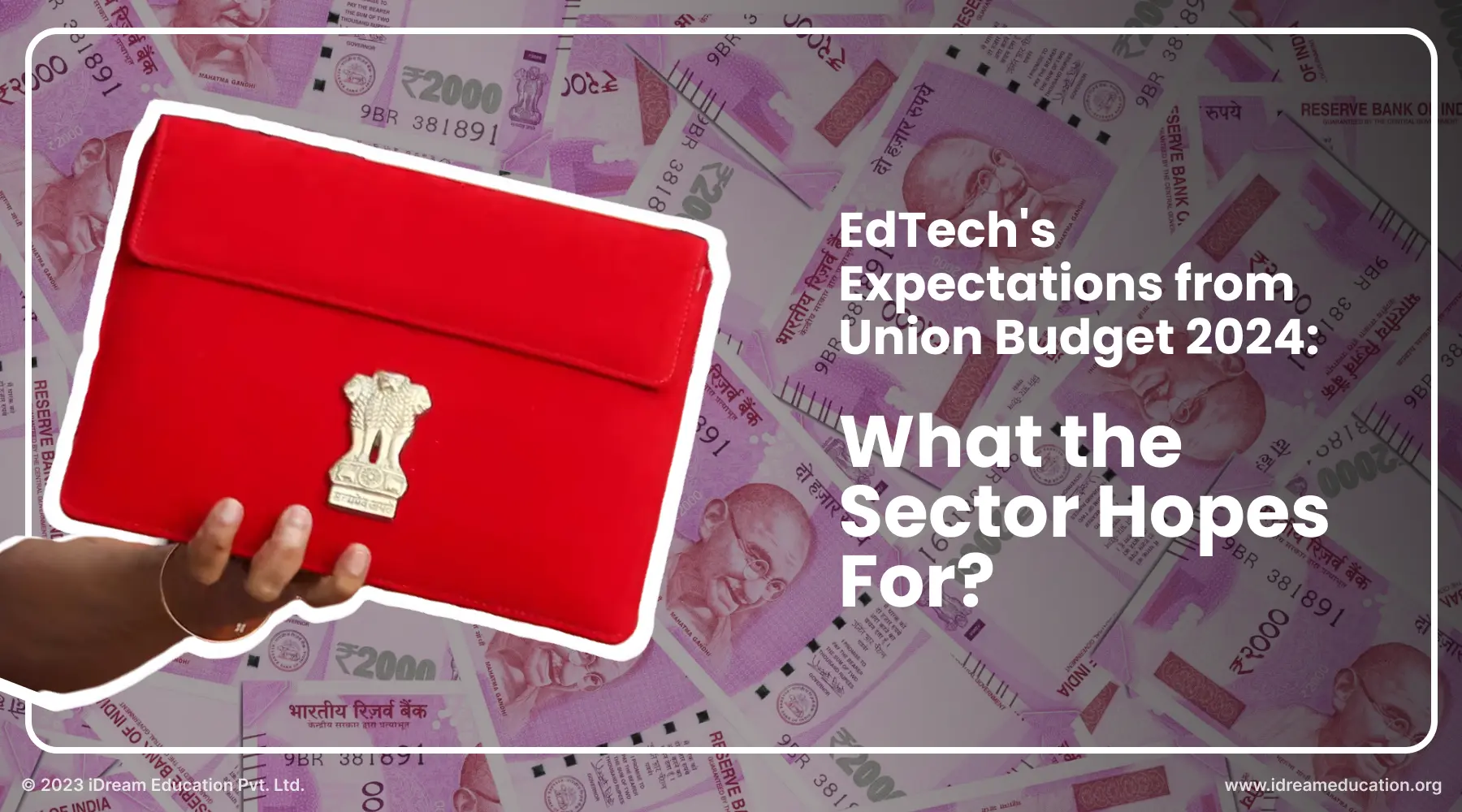Digital Education in India: The Current State
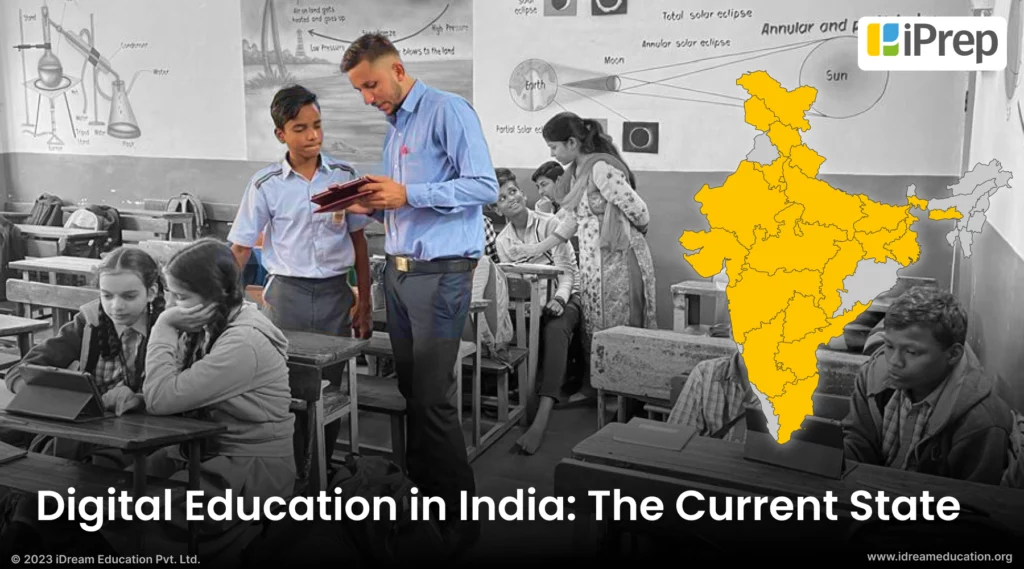
The term “digital education” has gained a great deal of popularity and importance, especially in relation to India. India is placing more focus on digital education, which is fitting given its critical role in improving the country’s educational system. The widespread adoption of digital education in India is a serious goal shared by governmental agencies, educational institutions, EdTech companies, and corporate social responsibility (CSR) initiatives.
With the current state of digital education in India, educators are realizing how important it is to include digital elements in their lesson plans. This covers the use of digital tests, smart classrooms, and an abundance of educational resources. These methods are now standard practice, ensuring that pupils are ready to manage a world that is becoming more and more digitally savvy.
Likewise, companies are pivotal in fortifying educational activities concerning digital education in India. They are focusing their resources on technology because they see its potential to improve education. These days, a lot of businesses fund educational initiatives, provide essential materials, and help build digital infrastructure for underserved areas and schools. This deliberate effort is leading to a big impact on how digital education in India is shaping up.
Let us first understand what is a digital education
Digital education is the incorporation and use of various digital technologies and tools in the educational environment to improve the learning experience and outcomes. It employs digital devices, software applications, and interactive content to facilitate the instructing and learning process. This strategy utilizes the capabilities of digital tools to make learning more engaging, individualized, and efficient.
Digital Education predominantly entails the use of smart classrooms, tablet-based digital libraries, learning tablets, and mobile/ web applications related to education. The purpose of these tools is to provide students with access to a vast assortment of educational resources, interactive content, and activities that go beyond traditional textbooks and classroom instruction.
Digital education can take many forms, including:
- Courses and Platforms: These web-based systems or programs offer a broad range of courses on various topics.
- Educational Apps: These smartphone apps aim to provide exercises, activities, and instructional information.
- Interactive Multimedia: This includes instructive films, role-playing games, animated films, simulations, and other multimedia materials https://www.arabickeyboardonline.com/ that improve comprehension and interaction.
- Assessments and Tests: Digital tools frequently provide students with rapid feedback during tests and assessments.
- E-books and Digital Textbooks: Digital textbooks that can be viewed and read on digital devices are electronic-format versions of printed textbooks.
The iPrep platform integrates the several facets of digital education stated above. There is also a mobile application available. With the app, students may access and engage in more engaging and accessible learning while on the go. The platform is designed to deliver instructional information, exercises, and activities. It also includes a variety of multimedia content, such as interactive activities, animations, simulations, and videos. These resources offer a dynamic learning environment by improving comprehension and engagement. The platform works on almost all devices and operating systems and works online as well as offline in a classroom, lab, PC, web, tablet, or smartphone.
Digital instruments for administering tests and evaluations are part of iPrep. These tests frequently give students instant feedback, enabling them to monitor their development and pinpoint areas in need of improvement. Additionally, it offers electronic textbooks and instructional resources that are accessible and readable on a range of digital devices, including computers, tablets, and smartphones.
What is Digital Education In the Indian Context?
Thanks to a mix of increased demand for high-quality education and technical improvements, digital education has become a major force in India in recent years. In order to encourage digital education throughout the nation, the Indian government and a number of private companies have launched a number of initiatives and platforms.
Initiatives such as the PM Shri, Samagra Shiksha Abhiyan, Nipun Bharat, PM E-Vidya, Swayam Prabha, VidyaDaan, and E-pathshala are pivotal in expanding access to high-quality educational resources. Additionally, educational institutions, both public and private, have been quick to adopt digital tools and platforms to ensure uninterrupted learning
Digital education in India has the power to close achievement gaps, raise standards, and broaden access to education. Digital education in India is a dynamic landscape, always expanding and changing to meet the country’s ever-changing demands and keep up with technological breakthroughs. It is seen as the way of the future for learning and education and its role is central in meeting UN SDGs and Economic Development Goals of India.
Discussed further in this blog are the initiatives taken up by the Government for Digital Education in India. Let us now understand the government initiatives that are trying to embrace digital education in India
Government initiatives for digital education in India
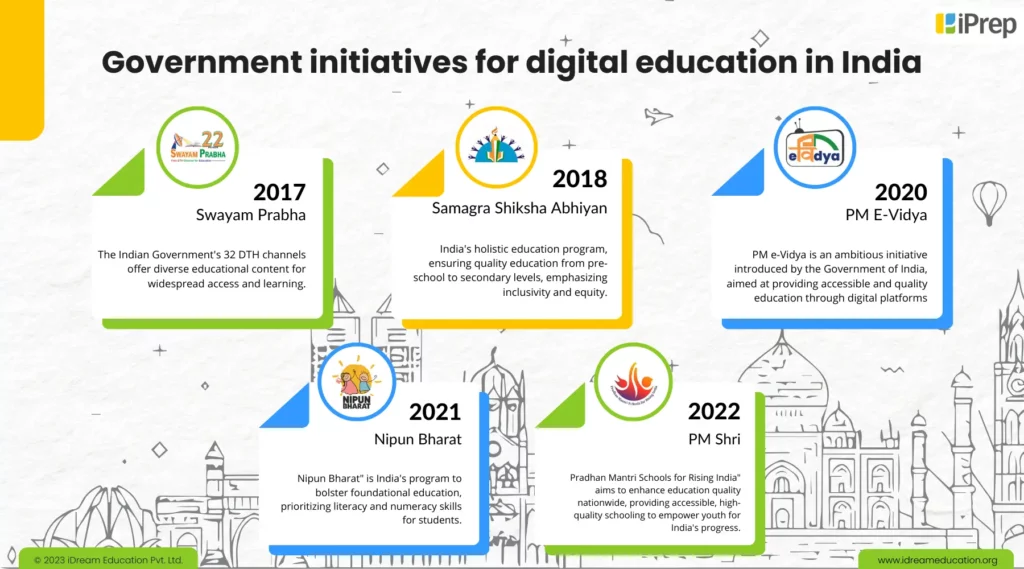
PM SHRI Initiative
PM SHRI is a visionary initiative launched by the Government of India, designed to improve school education in India. It is closely aligned with the New Education Policy (NEP) of 2020, reflecting a transformative approach to Digital education in India.
More than 14,500 PM Shri Schools are to be established under the PM Shri Scheme. The planned period of operation for this project is the 2022–2023 to 2026–2027 fiscal year. The PM Shri Scheme’s coverage has found and added 6,448 schools, with about 20 lakh kids in India expected to directly benefit from high-quality digital education as one of the program’s anticipated benefits.
PM Shri upholds the fundamental ideas of the NEP 2020, which enhances its goals. It encourages curricular flexibility, innovation, and critical thinking. In keeping with the NEP’s goal of a more dynamic and learner-centric educational system, it also places a strong emphasis on experiential learning and aims to lessen rote memorization (learning via repetition).
Objectives of PM Shri
- Holistic Development: In addition to fostering academic achievement, PM Shri seeks to offer a holistic education that emphasizes mental health, physical fitness, and artistic expression. This is consistent with the NEP’s focus on a multifaceted, holistic approach to education.
- Technological Integration: Technology integration in education is given a lot of weight in this project. In keeping with the NEP’s goal of utilizing technology for efficient teaching, it acknowledges the critical role that digital tools and platforms play in contemporary learning contexts.
- Inclusivity and Accessibility: PM Shri is dedicated to ensuring that education is available to everyone, irrespective of socioeconomic status, geographic location, or any other possible obstacles. It is consistent with the NEP’s focus on inclusive education, which guarantees that all children have the chance to grow and develop.
The end results that PM Shri’s initiative is trying to achieve are as follows:-
- Empowered Learners: The ultimate objective of PM Shri is to generate capable students who are not only academically adept but also have a variety of abilities and attributes necessary for success in the twenty-first century.
- Technologically-Competent Citizens: PM Shri’s focus on technological integration is in line with the NEP’s emphasis on using technology to facilitate effective digital learning, as it seeks to provide students with the digital skills required for the modern workforce.
- Inclusive Education Ecosystem: PM Shri is dedicated to fostering an inclusive and accessible learning environment where all children, regardless of background, have an equal chance to succeed.
Samagra Shiksha Abhiyan
A major initiative of the Indian government, the Samagra Shiksha Abhiyan seeks to offer inclusive, high-quality education to all children from preschool through upper secondary education. With over 1.6 million schools serving over 156 million students and 5.7 million government-employed teachers receiving educational support, the Samagra Shiksha program is the largest in the country. Notably, this program is essential to the advancement of digital education in India and is consistent with the country’s goal of using technology to improve learning outcomes.
Samagra Shiksha Abhiyan and the National Education Policy (NEP) of 2020 are closely related initiatives that aim to bring about a noticeable change in digital education in India. It takes into account the NEP’s focus on experiential learning, multidisciplinary approaches, holistic development, and foundational reading and numeracy.
Objectives of Samagra Shiksha Abhiyan
- Foundational Learning: By the end or conclusion of Grade 3, the program seeks to ensure that every kid in India can read and perform basic math in addition to having had the opportunity to use digital learning resources. This aligns with the NEP’s emphasis on utilizing technology to enhance learning and begin school early.
- Holistic Development: It seeks to provide every kid in India with a comprehensive education, encompassing both subject-specific learning and the use of digital learning resources. The main goals of this instruction are to ensure that children are technologically literate, creative, joyful, and healthy. This is in line with NEP’s holistic learning strategy, which emphasizes the value of traditional and digital teaching approaches for digital education in India.
- Equitable Access, including Digital Education: The Samagra Shiksha Abhiyan works to close educational inequalities, particularly in underprivileged areas and groups, so that all children in India, regardless of their circumstances, have equitable access to high-quality digital education. This project recognizes technology as a critical instrument for improving learning possibilities and highlights the significance of digital education in India.
- Quality Education, with a Focus on Digital Learning: By providing relevant training for educators, updating curricula, and improving instructional materials, the program seeks to improve the quality of digital education in India. Additionally, it highlights the incorporation of digital education in India, acknowledging the role that technology plays in enhancing the educational process.
The end result that the Samagra Shiksha Abhiyan initiative is trying to achieve is mentioned below
Aligned with the NEP, the ultimate aim of Samagra Shiksha Abhiyan is to provide every child with the values, knowledge, and skills required for their personal and societal well-being, including competency in digital education in India, in addition to academic brilliance. The program leverages the benefits of digital education in India to build a generation of empowered, creative, and critical thinkers who can meaningfully contribute to the nation’s advancement by emphasizing foundational learning, holistic development, and equitable access.
Nipun Bharat
One of the most important programs under the 2020 National Education Policy (NEP) is Nipun Bharat, which aims to improve digital education in India or children’s fundamental abilities. Early childhood education and basic literacy and numeracy skills are given a lot of weight. The Nipun Bharat Mission will give particular attention to kids between the ages of three and nine, which includes preschoolers through third graders. Those who don’t have the fundamentals will get committed, teacher-led help and support. Alongside this, the project will integrate digital education in India, guaranteeing a thorough strategy to support young students’ academic growth.
The NEP’s vision, which emphasizes the critical role that fundamental reading and numeracy play in a child’s educational path, is exactly aligned with Nipun Bharat. It fits in with the NEP’s emphasis on early education as a critical time for cognitive growth.
Objectives of Nipun Bharat
- Foundational Learning with Digital Education: By the time children enter Grade 3, all children in the nation, regardless of background, should have acquired the fundamentals of reading and numeracy, according to Nipun Bharat. This goal is in line with the NEP’s focus on foundational education, which also acknowledges the critical role that it plays in digital education in India.
- Holistic Development with Digital Education in India: The program recognizes that education is more than just academics. It highlights a child’s whole development, including their physical, social, and emotional health. It also emphasizes the necessity of incorporating digital education, which is consistent with India’s goal of developing technological learning approaches.
- Early Childhood Education: Early childhood education is crucial, as Nipun Bharat emphasizes, as it lays a solid foundation for further learning.
- Customized Learning Plans: It makes an effort to recognize and meet each child’s unique learning needs to create an atmosphere in which they can flourish both intellectually and socially.
The end result that the Nipun Bharat initiative is trying to achieve is mentioned below
In line with the NEP, Nipun Bharat seeks to embrace the advantages of digital education in India while making sure that every kid in the country has a solid foundation in reading and numeracy. With an emphasis on foundational learning and early education, the program hopes to inspire a lifelong love of learning in kids and provide them with the tools and resources they need to use digital tools and resources to reach their full potential.
PM E-Vidya
The Government established PM E-Vidya, an innovative effort with a clear goal of using technology to improve digital education in India. It is in perfect harmony with the 2020 National Education Policy (NEP), which places a strong emphasis on using technology in India’s digital educational ecosystem. Over 25 crore school-age children are expected to benefit from the Prime Minister’s E-Vidya project. This noble attempt also includes a crucial emphasis on digital education in India’s integration, which will provide the country’s youth with a comprehensive and technologically enhanced education.
The NEP’s goal of an educational landscape that is tech-savvy and aligned with PM E-Vidya is a great fit. It acknowledges the transformative power of digital technologies and platforms in offering students of all ages affordable, inclusive, and excellent digital education in India.
Objectives of PM E-Vidya
Multi-Mode Learning: With a focus on digital education in India, PM E-Vidya seeks to offer a multimodal learning experience that integrates online, offline, and broadcast learning modalities. This guarantees that a variety of students, regardless of their access to digital devices, can access educational content.
Universal Access: The effort aims to provide high-quality education, including digital education, to all regions of the nation, especially underserved and distant locations. It increases access to digital education in India by using technology to overcome geographic barriers.
Teacher training: The curriculum focuses a lot of emphasis on teaching Indian educators how to use digital technologies efficiently so they can design memorable and stimulating lessons in the realm of digital education.
The result that the PM E-Vidya initiative is trying to achieve is mentioned below
Aligned with the National Education Policy (NEP), PM E-Vidya aims to facilitate digital education in India by leveraging technology to develop digital education. The program intends to level the playing field for students nationwide by providing a wide variety of learning modes and guaranteeing universal access, ensuring that every student has the chance to gain from technological improvements in the education sector.
Swayam Prabha
A program by the Indian government called Swayam Prabha aims to provide Direct-to-Home (DTH) channels with top-notch educational content. This project perfectly aligns with the National Education Policy (NEP) of 2020, which emphasizes the importance of utilizing technology to offer high-quality education access. Swayam Prabha comprises 34 DTH channels dedicated solely to broadcasting top-notch educational content around the clock, 24 hours a day. This project makes use of the GSAT-15 Satellite to enable smooth information distribution. This technical development offers a broad and dependable platform for educational enrichment throughout the country, marking a noteworthy step towards improving digital education in India.
The educational programming available on the Swayam Prabha DTH channels is extensive and meets the needs of both higher education and classroom instruction (grades 9–12). These platforms provide carefully chosen curriculum-based courses, providing students in grades 11 and 12 with crucial support. This program is a significant step forward for digital education in India since it offers a wide range of academic levels and a full platform for academic progress.
Swayam Prabha completely agrees with the NEP’s goal of utilizing technology to make education easily accessible. It acknowledges that broadcasting has the potential to be an effective instrument for reaching students in underserved and rural places.
Objectives of Swayam Prabha
Reach Every Corner: Swayam Prabha wants to make sure that even the most isolated and unreachable regions of the nation have access to high-quality educational materials, including digital education. Through the use of DTH technology, learners in India can access digital education regardless of their geographic location.
Diverse Learning Resources: The program offers a wide variety of educational materials covering a range of topics and specializations. This meets the various interests and learning requirements of pupils in various age groups for digital education in India.
The end result that the Swayam Prabha initiative is trying to achieve is mentioned below
Swayam Prabha’s mission, as stated in the NEP, is to make digital education easily accessible in India by giving everyone, regardless of location or socioeconomic status, access to excellent learning resources, including digital education. The program seeks to enhance digital education in India by leveraging broadcasting technology to provide a more accessible and inclusive learning environment for all.
Now let’s talk about some initiatives that solely focus on technology-driven education.
Government Initiatives That Solely Focus On Technology-Driven Education
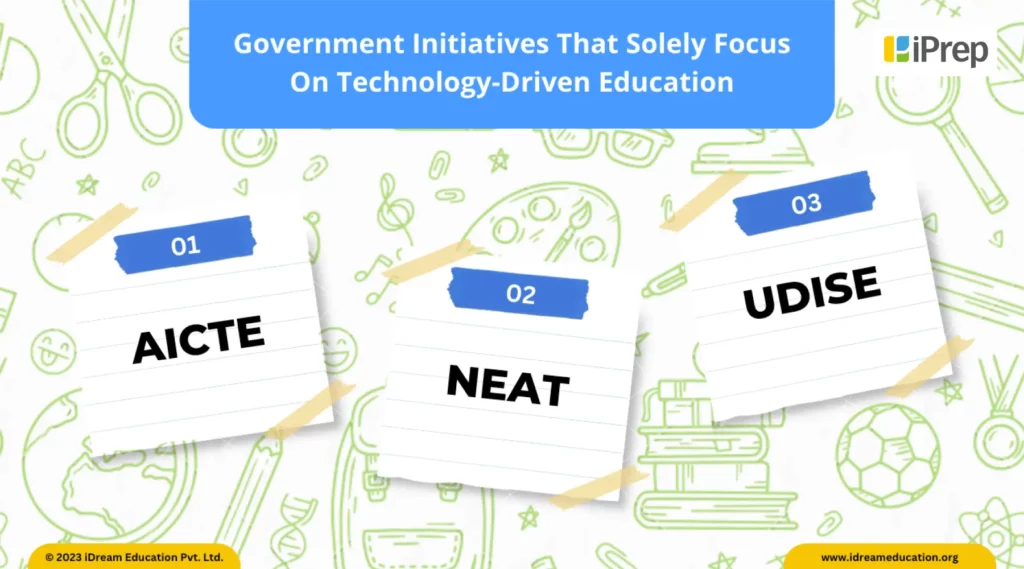
AICTE
The All India Council for Technical Education (AICTE) was established in 1945, gaining statutory status in 1987. It approves new technical institutions, courses, and intake variations, delegating some powers to state governments. AICTE sets norms, accredits programs, and promotes technical education through schemes for women, persons with disability, and weaker sections. It covers post-graduate, undergraduate, and diploma programs in engineering, canadian pharmacy, architecture, and more. Headquarters are in New Delhi with regional offices nationwide. A new office in Hyderabad is upcoming. The AICTE functions through an Executive Committee. The main distinction from the University Grants Commission (UGC) is AICTE’s focus on technical courses, while UGC oversees non-technical education.
Objectives of AICTE
- Promotion of Quality Education: AICTE is responsible for promoting quality education in the field of technical and management education in India. It works towards maintaining and improving the standards of technical education.
- Recognition and Accreditation: AICTE is involved in the recognition and accreditation of institutions offering technical education. It establishes norms and standards for the programs and ensures that institutions adhere to these standards.
- Equity and Access: AICTE works towards promoting equity and access to technical education. It strives to ensure that education opportunities are accessible to all, regardless of socioeconomic factors or geographic location.
Steps taken by AICTE to achieve these objectives
To accomplish its main goals, the All India Council for Technical Education (AICTE) uses a variety of strategies. AICTE monitors colleges on a regular basis to guarantee compliance while enforcing strict norms and standards for technical and management programs in the interest of fostering high-quality education. The council takes an active role in curriculum creation, modifying course material to reflect changes in technology and industry standards. Fostering a culture of continuous growth, AICTE supports faculty development programs that strengthen teaching and research capacity.
AICTE conducts a methodical review procedure in order to obtain recognition and certification. Accrediting agencies work with AICTE to evaluate universities in comparison to predetermined quality criteria. In order to address issues of fairness and access, AICTE works to ensure that technical education is available to everyone, regardless of socioeconomic background. It also fosters inclusivity by implementing programs that improve possibilities for students from disadvantaged backgrounds and geographic areas. By means of these combined initiatives, AICTE hopes to improve technical education in India as a whole, making it more industry-responsive and inclusive of a wide range of students.
NEAT
National Education Alliance for Technology (NEAT) is a Public-Private Partnership model between the Government and the Education Technology companies of India. NEAT is a comprehensive platform for online education that provides access to a wide range of products from the industry. The Ministry of Human Resource Development ensures that students from rural areas or students having financial condition problems get access to some free coupons during their participation in the neat cell. This establishes a standard education procedure that is in alignment with the national education policy. When a student starts a question, his or her curiosity will be built and they will start learning on their own. If students look at the practical aspect of their knowledge, they will learn better. NEAT aims to help the student by providing different types of courses to Learn across the country.
This is the foundation of the future of India. This is the moment that is planting the seeds of a new era.
The Neat Initiatives also recognize the iPrep PAL as a prominent platform that places a strong emphasis on leveraging technology to facilitate digital education in India. To know more click here
Objectives of NEAT
- It aims to make learning more convenient by providing a one-stop portal for the best ed-tech solutions.
- It aims to improve the employability of young people by enabling them to learn skills that are in demand in the market.
- Its focus is on skill areas that can translate into gainful employment.
- It aims to make education and digital learning more accessible to socially and economically disadvantaged students.
- It seeks to make the most of Artificial Intelligence and Adaptive Learning technologies to support personalized learning for diverse learners
Steps taken by NEAT to achieve these objectives.
NEAT has launched a user-friendly, centralized online portal that aggregates the best educational technology solutions. This one-stop platform provides learners with easy access to a diverse range of courses, materials, and tools, enhancing the convenience of their learning experience. It has also conducted thorough market research in collaboration with industry experts to identify skills in high demand. Based on this research, the alliance has curated a set of courses that directly address the current needs of the job market, with a specific focus on enhancing the employability of young learners. Recognizing the importance of gaining skills that lead to gainful employment, NEAT has tailored its course offerings to concentrate on specific skill areas that have a direct correlation with job placement and career advancement.
NEAT has implemented initiatives to improve accessibility, especially for socially and economically disadvantaged students. This includes offering subsidized or free courses, partnering with educational institutions to reach underserved communities, and leveraging technology to ensure that digital learning is accessible even in areas with limited infrastructure.NEAT has also integrated Artificial Intelligence and Adaptive Learning technologies into its platform. These technologies enable personalized learning experiences by adapting content and pacing to the individual needs of diverse learners. To amplify its impact, NEAT has forged strategic partnerships with educational institutions, industry leaders, and technology providers. Collaborations with government agencies and non-profit organizations have been established to broaden the reach of NEAT’s initiatives and ensure a more inclusive educational landscape.
UDISE
The Unified District Information System for Education (UDISE) was initiated in 2012-13. It is one of the largest Management Information Systems in School Education.
UDISE+ is an updated version of UDISE, where the data from the schools is collected online and in real-time. UDISE+ is a comprehensive Management Information System in School Education, covering over 15 lakh schools and more than 26.4 crore children. It addresses issues present in its predecessor. Developed in 2018-19, UDISE+ focuses on improving data capture, mapping, and verification.
In the 2020-21 academic year, 25.38 crore students were enrolled, with an increase of 28.32 lakh from the previous year. The Gross Enrolment Ratio improved across all levels. Teacher engagement increased to 96.96 lakh and 39.7 lakh students shifted to government schools due to the impact of COVID-19.
In 2021-22, enrolment increased to 25.57 crore, including growth in SC, ST, and OBC enrolments. The Gross Enrolment Ratio showed improvement, especially in higher secondary. The total enrolment of children with functional needs increased to 22.67 lakh.
Teacher numbers decreased in 2021-22, but PTR showed significant progress. Around 12.29 crore girls enrolled in primary to higher secondary education, showcasing increased participation. The total number of schools decreased to 14.89 lakhs, with 27% having special toilets for CWSN. Computer facilities were present in 44.85% of schools, and 77% had playground facilities.
These reports offer insights into the educational landscape, including enrolment trends, teacher statistics, gender representation, and school infrastructure status.
Objectives of UDISE
- Data Collection and Maintenance: One of the main objectives of UDISE is to collect and maintain accurate and up-to-date data on various aspects of school education. This includes information on schools, students, teachers, infrastructure, and other relevant parameters.
- Policy Planning and Implementation: UDISE serves as a crucial tool for policymakers in planning and implementing educational policies. The data collected through UDISE helps in understanding the current state of education, identifying areas that need improvement, and formulating targeted policies.
- Identification of Trends and Patterns: UDISE helps in identifying trends and patterns in educational indicators. This information is valuable for understanding factors influencing enrollment, dropout rates, and academic performance, enabling targeted interventions.
Steps taken by UDISE to achieve these objectives.
The Unified District Information System for Education (UDISE) employs a multifaceted approach to achieve its primary objectives. Firstly, for the objective of Data Collection and Maintenance, UDISE implements a systematic data-gathering process that involves regular updates from educational institutions. This includes information on schools, students, teachers, and infrastructure. UDISE establishes protocols to ensure the accuracy and currency of the collected data, utilizing technology for efficient storage and retrieval.
Secondly, in pursuit of Policy Planning and Implementation, UDISE serves as a crucial tool for policymakers by providing comprehensive data insights. The system facilitates the identification of areas that require targeted interventions and helps in formulating evidence-based policies. UDISE actively engages with educational authorities to ensure that the collected data aligns with policy objectives, enabling informed decision-making in the planning and implementation of educational initiatives.
Thirdly, UDISE is designed to facilitate the Identification of Trends and Patterns in education. Through data analytics and reporting mechanisms, the system allows for the identification of trends related to enrollment, dropout rates, academic performance, and other key indicators. This information is crucial for education authorities to discern patterns and make strategic decisions aimed at improving overall educational outcomes.
Now that we have talked about government initiatives for digital education in India, let us talk about CSR initiatives for digital education in India
Some CSR Initiatives for Digital Education In India
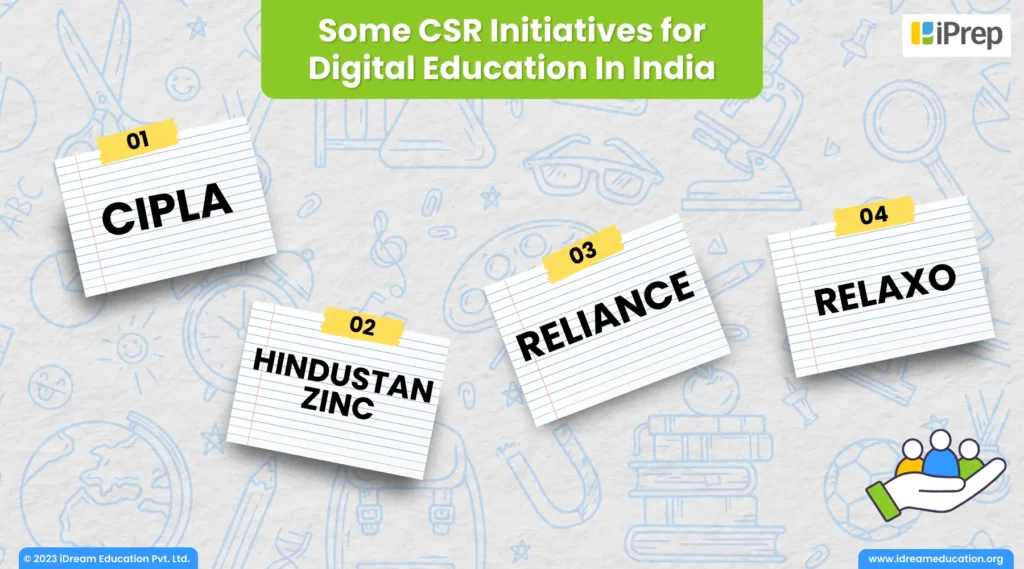
There are a lot of corporations that invest their CSR funds in the area of education as that is one of the most promising areas to plan CSR initiatives. Education has the potential to eventually eradicate the societal pains that every other CSR initiative may address. Whether it is food, shelter, unemployability, clean drinking water, electricity scarcity, etc, education has the power to uplift an individual, a family, or an entire locality out of these pains eventually. We here would like to highlight some of the Educational CSR initiatives that inspire us to a great extent.
1. Cipla
Cipla Foundation has partnered with various organizations to create wider access to education and learning opportunities for children. They aim to establish an enriching learning environment in identified Government and government-aided schools by providing facility enhancement support, ensuring that students have the necessary resources to continue their education.
The Cipla Foundation places particular emphasis on girl child education because gender crucially determines an individual’s level of education, disproportionately affecting women and girls. There is an evident disparity in literacy rates between males and females, creating a persistent barrier to education at both the primary and secondary levels. To address this issue, the Cipla Foundation has partnered with various potential organizations to support efforts that improve the enrolment and retention of out-of-school girls and enhance learning outcomes for primary-grade students in hundreds of villages in India. With the help of Cipla Foundation’s CSR initiatives, remedial learning has been provided to thousands of children.
During the COVID-19 pandemic, the Cipla Foundation partnered with NGOs to provide digital learning resources, equipment, and support for teachers in rural areas. They offered a Digital Library, Personalized Learning, and Digital Classrooms, benefiting thousands of students in India.
2. Hindustan Zinc
Hindustan Zinc is a subsidiary of Vedanta Limited. As part of its Corporate Social Responsibility (CSR) efforts, Hindustan Zinc has undertaken several initiatives to promote digital education in India. Here are some of their notable CSR initiatives in the field of education:
Khushi Nand Ghar (Anganwadi Programme)- This initiative primarily focuses on early childhood development and aims to comprehensively support children in their formative years by addressing holistic development, health, education, and community engagement. It has a positive and lasting impact on the lives of children and their families.
Shiksha Sambal– The program aims to address educational disparities and offer support to students, especially in rural and underserved areas. By addressing financial barriers, improving educational infrastructure, and providing skill-building opportunities, this program has the potential to significantly impact the educational landscape in the areas it serves.
Unchi Udaan- Hindustan Zinc operates this program to nurture the talents and aspirations of young individuals, particularly in the regions where it operates. By providing practical skills, career guidance, and entrepreneurial support, this program has the potential to make a substantial positive impact on the lives of young individuals.
3. Reliance
Through its Corporate Social Responsibility (CSR) initiatives, Reliance Industries actively promotes digital education in India.
It supports local schools with logistical and financial support, capacity building of teachers, and infrastructure development. It also nurtures and sponsors many projects designed to educate, employ, and empower women and youth in and around the catchment areas of its operations. One scheme of Reliance i.e. Dhirubhai Ambani Protsahan Scheme is a scheme for supporting meritorious students and providing financial aid to the toppers for pursuing higher studies in engineering and medical streams.
4. Relaxo
Relaxo is well recognized for its good corporate governance and CSR initiatives. At present, the Company is undertaking CSR projects in India which have directly & indirectly impacted the lives of approximately 2,00,000 people. The names of the projects are as follows:
Parivartan Model School Development Project- The project’s objectives include increasing public awareness of education, energizing school management committees, and carrying out construction and restoration projects inside the school.
Remedial Education Program: An educational initiative aims to provide targeted support and additional resources to students who may struggle with their studies.
It’s particularly important in addressing learning gaps and ensuring that every child has the opportunity to succeed academically.
Various organizations invest in the area of education through CSR with the aim of enhancing access to quality education for underserved learners in India. Altogether, we express great gratitude for all these organizations, and as an Ed-tech organization, we are ready to actively participate in any of these CSR initiatives directed towards enhancing access to quality digital education in India for the underserved.
iDream Education’s Solutions: Aligning with Initiatives for Digital Education in India
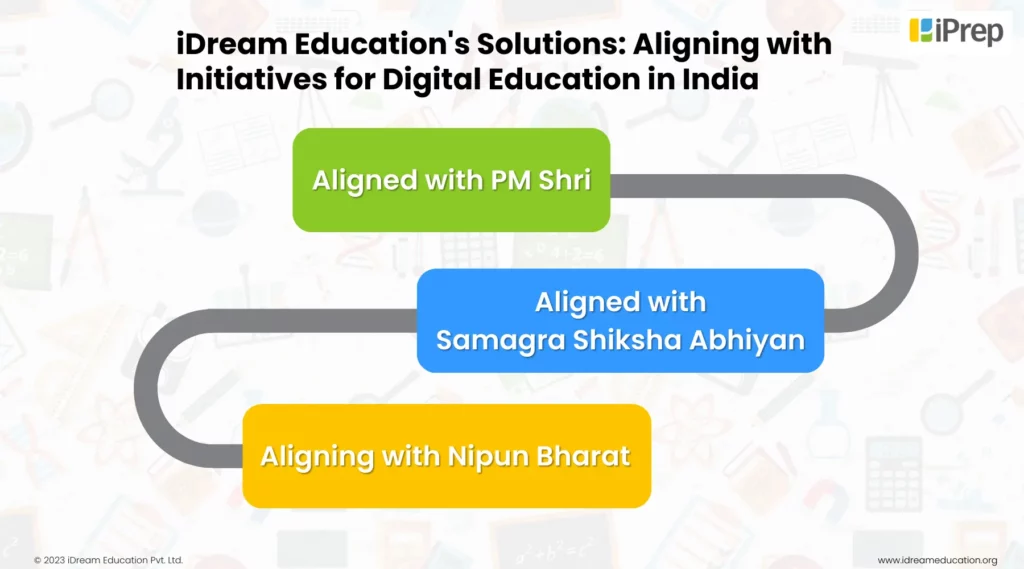
Aligning with PM Shri
iDream Education Solutions significantly contributes to digital education in India, aligning with the PM Shri initiative in various key ways:
Technological Integration: iDream promotes education through technology by providing a full range of digital learning resources, such as interactive classes, e-books, and other tools.
Quality Content Access: One objective is to fulfil PM Shri’s digital education goals by providing high-quality, curriculum-aligned content and improving the entire educational experience.
Inclusivity and Accessibility: In line with PM Shri’s efforts to promote inclusive education, iDream has designed solutions to reach a broad spectrum of pupils, including those residing in rural or underserved areas.
Alignment with NEP: In line with PM Shri’s initiatives to develop digital education, iDream’s solutions adhere to the 2020 National Education Policy (NEP), which emphasizes the integration of technology in education.
Aligning with Samagra Shiksha Abhiyan
iDream Education Solutions provides technology-driven educational resources and solutions that support government initiatives to improve Digital education in India, therefore aligning with the goals of the Samagra Shiksha Abhiyan. iDream education complements Samagra Shiksha Abhiyan in the following ways:
Digital Content & Curriculum: Supplying digital resources for improved teaching and learning that are in line with NCERT.
Technology Integration: Properly applying technology to successful education in keeping with Samagra Shiksha Abhiyan’s tech-driven methodology.
Access to Underserved Areas: Expanding education to far-flung areas while maintaining inclusivity in line with the goals of Samagra Shiksha Abhiyan.
Aligning with Nipun Bharat
The iDream education system is in line with Nipun Bharat for digital education in India in a dynamic educational environment. Here how iDream education complements Nipun Bharat is as follows:
Interactive Learning: Students can study through interactive content that can inspire active engagement and increase their grasp of fundamental themes with the aid of the iDream education system and iPrep digital classes.
Visual Learning: Teachers can boost students’ knowledge of Foundational Literacy and Numeracy (FLN) principles by utilizing multimedia information and visual aids in a smart classroom setup that includes interactive flat panels, digital whiteboards, and smart TVs.
Access to Resources: iPrep Digital Libraries, an iDream education solution, gives users access to a variety of e-learning materials, including tools for enhancing their reading and numeracy abilities.
Multilingual Content: Students from a variety of language backgrounds can benefit from the multilingual material of the iDream education solution iPrep, which facilitates the acquisition of Foundational Literacy and Numeracy (FLN) skills.
Let’s Conclude
In conclusion, a growing demand for high-quality education and the meeting of technical breakthroughs have led to a remarkable expansion and transition in digital education in the Indian landscape. With a focus on integrating digital education in India, government initiatives including PM Shri, Samagra Shiksha Abhiyan, Nipun Bharat, PM E-Vidya, and Swayam Prabha have been instrumental in increasing access to high-quality educational resources.
In addition to being in line with the National Education Policy (NEP), these programs show a progressive attitude to ensuring that every child has the values, abilities, and information required for both individual and societal well-being. They stress inclusivity, accessibility, and quality in the educational ecosystem and acknowledge the critical role that technology is playing in changing education.
Government initiatives like AICTE, NEAT, and UDISE showcase a comprehensive commitment to advancing technology-driven education in India. AICTE focuses on promoting quality education, recognition, and equity in technical and management fields. NEAT, a Public-Private Partnership, aims to enhance learning accessibility, employability, and inclusivity through a centralized online platform. UDISE, as a massive information system, collects real-time data for informed policy planning, recognizing trends, and ensuring data-driven decision-making in the education sector. These initiatives collectively contribute to the transformative potential of digital education, aligning with the national agenda for inclusive and high-quality learning.
What’s More
Furthermore, the corporate social responsibility (CSR) endeavours of companies such as Cipla, Hindustan Zinc, Reliance, and Relaxo highlight the joint endeavour to augment the availability of high-quality education, with particular emphasis on digital learning. These programs demonstrate a deep awareness of the role that education plays as a potent catalyst for social advancement.
Digital education has the potential to close educational disparities, enhance learning outcomes, and make education more inclusive and available to all as it develops further.
Essentially, government and business initiatives are guiding India toward a future in which all children can flourish intellectually, digitally, and personally. This group effort is evidence of the revolutionary potential of digital education in India.


